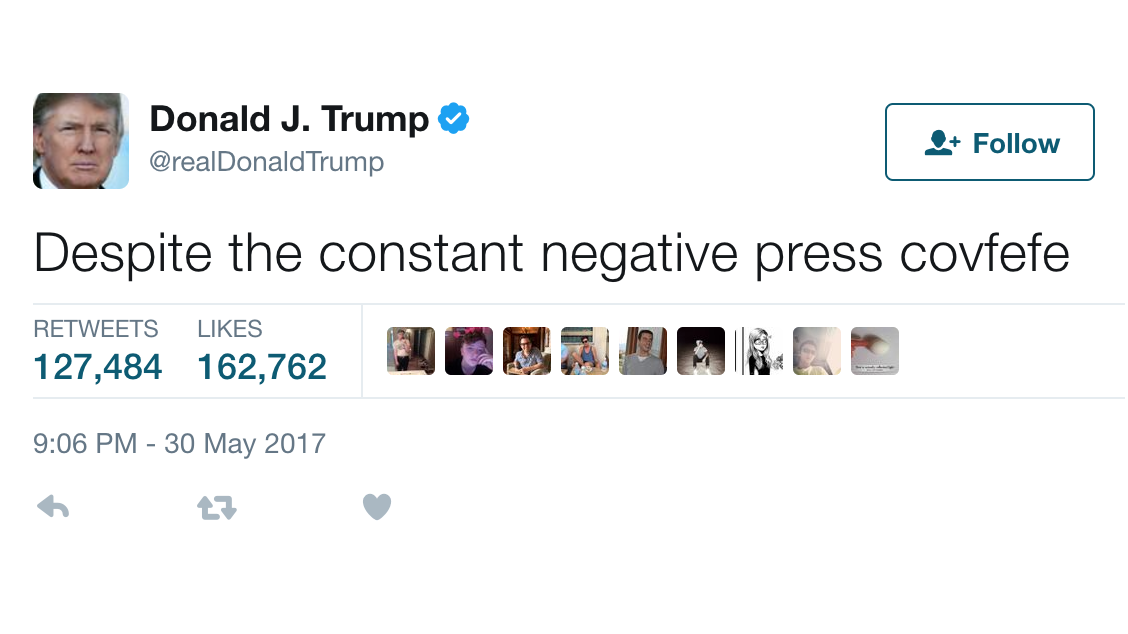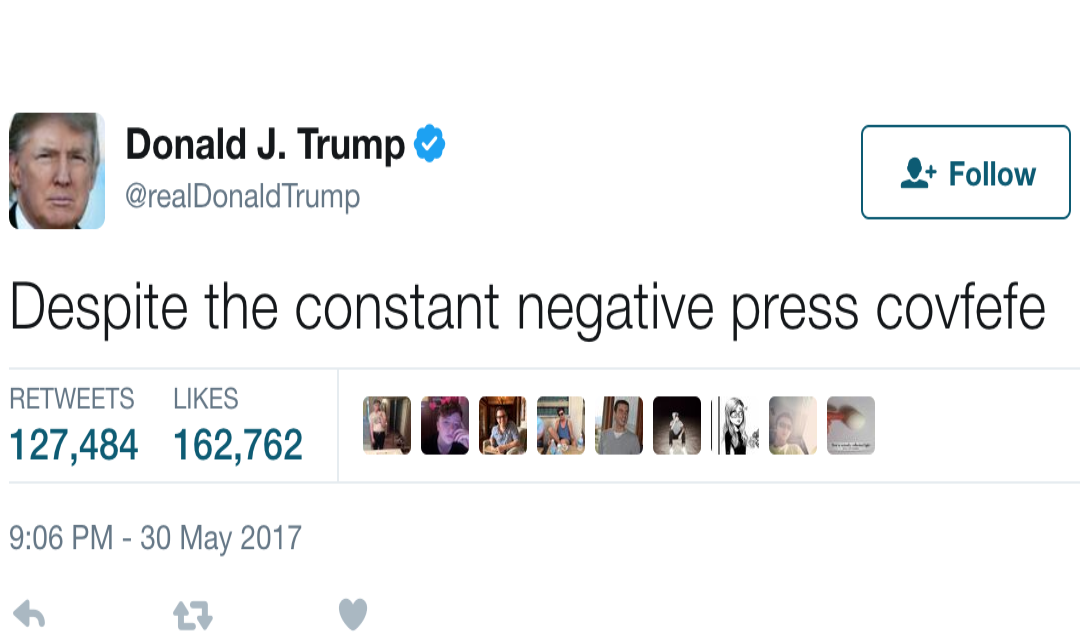 On May 31st, 2017, at 12:06 a.m. Eastern Time, President Donald Trump unleashed the following tweet: “Despite the constant negative press covfefe.” No one has been able to definitively crack the code (if there is one) as to what “covfefe” actually means. The President took down the tweet six hours later and replaced it with a tweet saying: “Who can figure out the true meaning of ‘covfefe’??? Enjoy!”
On May 31st, 2017, at 12:06 a.m. Eastern Time, President Donald Trump unleashed the following tweet: “Despite the constant negative press covfefe.” No one has been able to definitively crack the code (if there is one) as to what “covfefe” actually means. The President took down the tweet six hours later and replaced it with a tweet saying: “Who can figure out the true meaning of ‘covfefe’??? Enjoy!”
Predictably, the word “covfefe” immediately went viral on social media, with several twitter users encouraging their followers to “ask your doctor if Covfefe is right for you” and others thinking it’s what you’re supposed to say when someone sneezes. In the following days and weeks, covfefe has taken on a life of its own and become a bit of a cultural phenomenon. Late night hosts have debated whether President Trump had some sort of minor stroke or simply fell asleep when he typed covfefe, and Hillary Clinton was asked about what she thought it meant in a recent public appearance.
However, it’s not only comedians and 24-hour news channels that are making hay with covfefe. A Google search of “covfefe” reveals dozens of businesses ready to sell you apparel with hundreds of variations on the covfefe theme. To date, my personal favorites are “Make America Covfefe Again” and “What Part of Covfefe Don’t You Understand?”
A check of the U.S. Patent and Trademark Office (“USPTO”) databases shows that in the forty days since the covfefe phenomenon began, 34 trademark applications have been filed using the term. The products and services being tied to covfefe run the gamut from “advice relating to investments” to fragrances, toys, coloring books, and even sandwiches. As you might expect, four different companies have filed applications to use covfefe for beer.
However, easily the most popular application (there are about twenty of them) is to get protection for using covfefe on t-shirts, hats, and other apparel. One applicant for a covfefe apparel trademark even appears to have access to the inner circle of Trump advisors and confidants who know what covfefe really means – after all, its application is for: “COVFEFE – Carry On Vigilantly Fighting Evil For Ever.”
So, the question becomes: which of these applicants will win the coveted “covfefe” trademark for t-shirts? The answer from this trademark attorney is: very possibly none of them! Why? Because the USPTO will generally refuse an application as “ornamental” if what is submitted to the USPTO shows that the use of the mark is only decorative or ornamental. That is, if the use of the mark does not clearly identify the source of the goods and distinguish them from the goods of others – which is required for proper trademark use.
The USPTO’s number one example of “ornamental” use is when a quote is prominently displayed across the front of a t-shirt, such as “The Pen is Mightier than the Sword.” The USPTO’s position is that most purchasers would perceive the quote as a decoration, and would not think that it identifies the manufacturer of the t-shirts (the source of the t-shirts could be Hanes® or Champion®, for example, as shown by the neck-tag).
Other examples of “ornamental use” put out by the USPTO are:
- A logo on the front of a hat. When the logo is associated with an organization, like a sports team, which did not manufacture the hat.
- Stitching designs on the back pocket of a pair of jeans. Purchasers are accustomed to seeing embellishments on jean pockets and would not think this embroidery design identifies the source of the jeans.
- A floral pattern on tableware or silverware. A purchaser would likely see this pattern as merely decorative and would not think it identifies the source of the tableware or silverware.
- The phrase “Have a Nice Day” or a smiley face logo. Everyday expressions and symbols that commonly adorn products are normally not perceived as identifying the source of the goods.
While there is no definitive place to affix a mark to goods to avoid an ornamental refusal, the location, size and dominance of a mark have a big impact on how the public perceives it. The USPTO has offered the following examples of proper non-ornamental trademark use:
- Discrete wording or design on the pocket or breast portion of a shirt. A purchaser would typically associate the small logo on a shirt pocket or breast area with the manufacturer or the source of the shirt.
- A tag on the inside of a hat or garment. A purchaser would associate a logo on the tag with the maker of the garment.
- Logo on a tag above the back pocket of a pair of jeans. A purchaser would typically associate this mark with the manufacturer of the jeans.
- A small logo stamped on the back of a dinner plate or bottom of a coffee mug. Purchasers are accustomed to seeing a mark used in this location to identify the source of the tableware.
Another way to get around an “ornamental use” refusal from the USPTO is to show that the mark has “acquired distinctiveness.” Long-term use in commerce, advertising and sales figures, dealer and consumer statements, and other evidence can be used to show that consumers directly associate a mark with the source of those goods. While this probably won’t work for the covfefe applicants (since the term has only existed for about six weeks), it could be an option in your situation.
The final option for the covfefe trademark applicants would be to move their applications to the “Supplemental Register.” Registration on the Supplemental Register doesn’t provide all the same legal advantages as registration on the Principal Register, but it does provide protection if and when someone applies for a conflicting mark later. Also, after five years of continual use, you can apply for (and in most cases will be awarded) registration on Principal Register.
If you feel like you have captured “covfefe-like” lightning in a bottle, and want to talk about how to protect your name and/or logo, please give me a call at 435-596-9366 or shoot me an email at [email protected].
